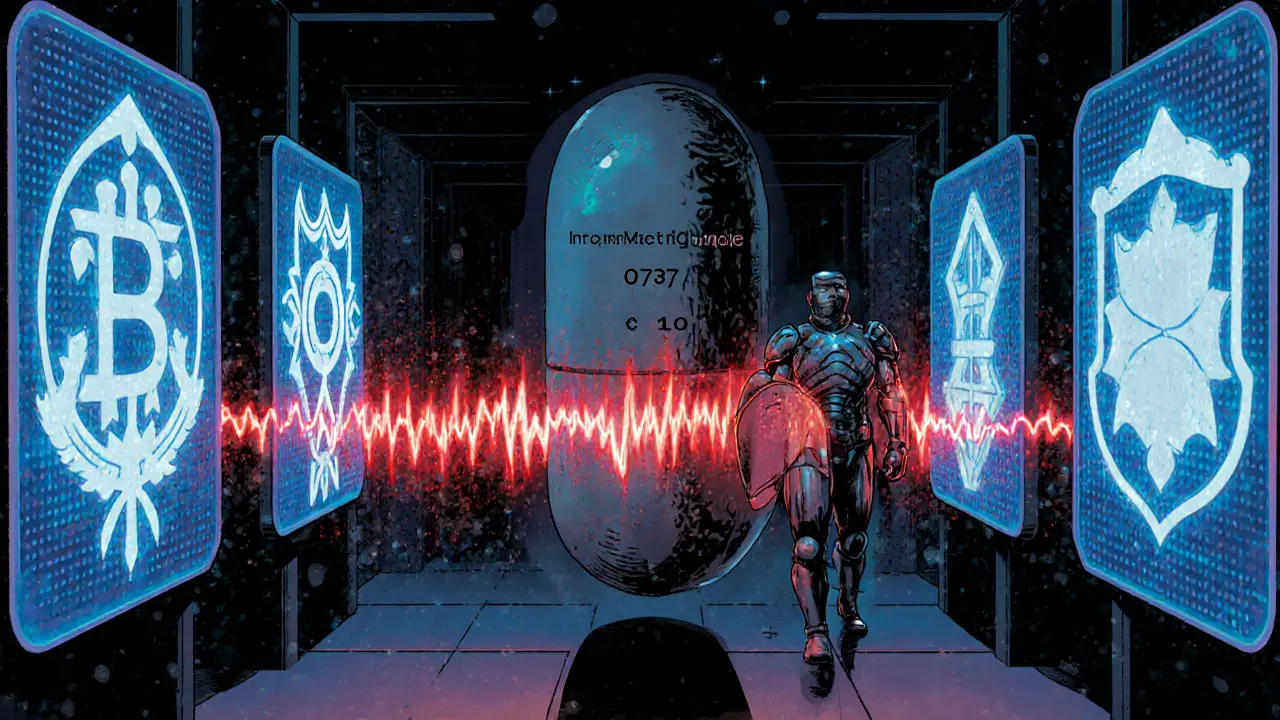Nonce Replay Protection Simulator
Click "Simulate Transaction" to begin.
Nonce Details
- Current Stored Nonce -
- Transaction Nonce -
- Chain ID -
- Replay Status -
Quick Summary
- Nonces are unique numbers that make each signed transaction one‑time‑use.
- Ethereum stores a per‑address counter; Bitcoin uses a random nonce for mining.
- Combining a chain ID with a nonce stops cross‑chain replay attacks.
- Smart contracts must track nonces per signer to avoid signature reuse.
- Follow the checklist at the end to keep your nonce implementation safe.
When you send a crypto transaction, you want to be sure nobody can grab the signed payload and resend it later. That’s where a nonce is a unique number used once that guarantees each message or transaction is fresh. By attaching a fresh nonce to every signed action, the network can quickly spot a duplicate and reject it, closing the door on replay attacks.
How a Nonce Stops Replay Attacks
Replay attacks work by intercepting a validly signed transaction and broadcasting it again. If the network accepts it, the attacker could double‑spend or trigger unwanted contract calls. The nonce solves this in two ways:
- Uniqueness: Every transaction must carry a nonce that no previous transaction from the same address has used.
- Ordering: Nodes compare the incoming nonce against the stored counter. If the number is out of sequence, the transaction is discarded.
Because the nonce lives in the blockchain’s world state, a malicious actor cannot simply guess a new value; they would need to know the exact next counter, which only the legitimate sender’s client can predict.
Different Flavors of Nonce
Not all nonces are created equal. Depending on the context, the term refers to distinct mechanisms:
| Type | Purpose | Generation Method | Example Platform |
|---|---|---|---|
| Transaction Nonce | Ensures each signed transaction is unique and ordered. | Sequential counter stored in the world state. | Ethereum |
| Mining Nonce | Provides a variable input for proof‑of‑work hash puzzles. | Random or incremental number tried until a hash meets difficulty. | Bitcoin |
| Application (Smart‑Contract) Nonce | Prevents replay of signed messages inside contracts. | Mapping of signer → last used number, often incremented per call. | Solidity Smart Contracts |
Understanding which nonce you’re dealing with is the first step to designing a secure system.
Ethereum Transaction Nonce in Detail
In Ethereum a public, permissionless blockchain that uses account‑based state, every externally‑owned account (EOA) maintains a counter called the transaction nonce. When you sign a transaction, the client inserts the current counter value. After the block containing the transaction is mined, the network increments the stored nonce for that address.
What does this buy you?
- **Ordering** - Transactions with lower nonces must be mined first, preserving logical order.
- **Replay resistance** - A second broadcast of the same signed payload will contain an already‑used nonce, so every node rejects it.
- **Front‑running mitigation** - Attackers can’t swap the nonce to squeeze in between your pending transactions without crafting a higher nonce, which would break the sequence.
Developers often see nonce‑related errors when they send multiple transactions too quickly. The solution is to manage a local nonce pool or query the network for the latest value before each send.
Mining Nonce: The Proof‑of‑Work Engine
While Ethereum’s transaction nonce is about ordering, the Bitcoin a proof‑of‑work blockchain where miners compete to find a valid hash uses a mining nonce to vary the block header hash. Miners iterate over 32‑bit (or larger) nonce values, each time hashing the block header until the resulting hash is below the network’s target.
Even though the mining nonce isn’t directly tied to replay protection for user transactions, it shares the principle of “one‑time use.” Once a miner finds a nonce that satisfies the difficulty, that exact nonce cannot be reused for the same block header; the block is now immutable.

Application Nonce Inside Smart Contracts
Smart contracts often require off‑chain signatures - think meta‑transactions or permit‑style approvals. In these cases, the contract itself must enforce a nonce to stop a captured signature from being replayed.
A typical Solidity pattern looks like this:
mapping(address => uint256) public lastNonce;
function executeSigned(address signer, bytes calldata data, uint256 nonce, bytes calldata sig) external {
require(nonce == lastNonce[signer] + 1, "Invalid nonce");
require(_verify(sig, signer, data, nonce), "Bad signature");
lastNonce[signer] = nonce;
// … execute action …
}
The smart contract self‑executing code on a blockchain that can hold state and enforce rules now guarantees every signed message is used once.
Chain ID + Nonce: Guarding Against Cross‑Chain Replays
After the 2016 Ethereum‑Classic fork, attackers could replay a transaction on both chains because the payload looked identical. Ethereum answered with EIP‑155 an improvement proposal that adds a chain identifier to the transaction signature. The new signing formula mixes the chain ID, the transaction nonce, and the usual fields, producing a signature that is only valid on the intended network.
In practice:
- Ethereum mainnet uses chain ID
1. - Optimism uses chain ID
10. - Polygon PoS uses chain ID
137.
When a transaction includes the correct chain ID, trying to replay it on a network with a different ID fails the signature verification step, giving an extra layer of safety.
Common Pitfalls and How to Avoid Them
Even seasoned developers stumble into nonce‑related bugs. Here are the most frequent issues and quick fixes:
- Missing contract‑level nonce tracking - If a contract only checks the transaction nonce (the EOA’s counter) but accepts off‑chain signatures, an attacker can replay the signature on a different contract. Always store a per‑signer nonce inside the contract.
- Predictable nonces - Some developers generate nonces from timestamps alone. If the attacker can guess the next value, they could craft a pre‑signed message. Combine a counter with a random component.
- Nonce gaps - Sending transactions out of order leaves gaps in the stored counter, causing later valid transactions to be dropped. Either wait for each transaction to be mined or use a pool that fills gaps.
- Cross‑chain replay without chain ID - Forked networks that share the same address format can accept the same signed payload. Always include the chain ID, especially for contracts that might be deployed on multiple EVM chains.
Best‑Practice Checklist
- Use the blockchain‑provided transaction nonce for every EOA‑signed transaction.
- Implement a mapping
address => uint256inside any contract that verifies off‑chain signatures. - Include the chain ID in the signed payload (EIP‑155 or similar).
- Never rely on timestamps alone; blend counters with cryptographically secure random bytes.
- Test replay scenarios on a local testnet: resend a signed payload with the same nonce and confirm it’s rejected.
- Keep your nonce‑generation library up‑to‑date - newer versions often fix subtle predictability bugs.
Future Directions: Quantum‑Resistant and Multi‑Chain Nonces
As quantum computers loom, researchers are already exploring nonce algorithms that remain secure against quantum attacks. The idea is to use larger, lattice‑based random values that are infeasible to reverse‑engineer even with quantum advantage.
At the same time, multi‑chain wallets are adding “nonce managers” that keep separate counters for each network, preventing accidental cross‑chain replays without requiring manual tracking.
Summary
Nonces are the unsung heroes of blockchain security. Whether you’re sending a simple ETH transfer, mining a new Bitcoin block, or verifying a meta‑transaction inside a smart contract, a correctly‑handled nonce guarantees that the same signed data can’t be reused by an attacker. Pair the nonce with a chain ID, store per‑signer counters on‑chain, and avoid predictable generation - and you’ll have a solid defense against replay attacks.

Frequently Asked Questions
What exactly is a nonce in blockchain?
A nonce (number used once) is a unique value attached to a signed message or block header so that the same data cannot be accepted twice by the network.
Why does Ethereum need a transaction nonce?
Ethereum stores a per‑address counter. The nonce ensures transactions are processed in order and stops anyone from rebroadcasting an old signed transaction.
Can I reuse a nonce for a different smart contract?
No. Each contract that validates off‑chain signatures must keep its own nonce mapping. Reusing a nonce across contracts would let a captured signature be replayed on any contract that accepts the same format.
How does the chain ID protect against cross‑chain replay?
The chain ID is baked into the transaction’s signature (EIP‑155). A signature generated for chain ID1 will be invalid on a chain with ID10 because the signed payload differs, causing verification to fail.
What mistakes make a nonce predictable?
Generating nonces solely from timestamps or from a simple increment without random salt can let attackers guess the next value. Use a cryptographically secure random generator combined with a counter.



Shelley Arenson
April 27 2025Loved the clear breakdown of nonce usage! 😊
Joel Poncz
April 30 2025i think the part about chain id could've been a lil more detailed, but overall it's good.
Kris Roberts
May 4 2025Nonce is like the memory of a transaction, a single‑use ticket that guarantees each move is fresh.
When you forget to bump it, the network sees a déjà vu and discards the duplicate.
That’s why every wallet automatically increments the counter before signing.
Pairing it with a chain ID is like adding a unique fingerprint for each network, stopping cross‑chain repeats.
Think of it as a philosophical reminder: even digital actions need their own identity to matter.
lalit g
May 7 2025The explanation about per‑contract nonce tracking is especially useful for developers building meta‑transactions.
Keeping a mapping of address to uint256 inside the contract prevents off‑chain signatures from being replayed elsewhere.
It’s a simple pattern that adds a strong layer of security without much gas overhead.
Reid Priddy
May 11 2025Honestly, most devs ignore nonces anyway, so this is overkill.
Shamalama Dee
May 14 2025Great overview! For anyone implementing off‑chain signatures, remember to store the nonce on‑chain and increment it only after successful execution. This prevents race conditions and keeps the state consistent.
Dyeshanae Navarro
May 18 2025Simple tip: use a cryptographically secure random source when you create a nonce, then add a counter. It stops attackers from guessing the next value and keeps your transactions safe.
Matt Potter
May 21 2025Go ahead and test replay scenarios on a local testnet – send the same signed payload twice and watch it fail. That hands‑on experience cements the concept.
Marli Ramos
May 25 2025Meh, looks like a lot of fluff. 😒
Christina Lombardi-Somaschini
May 28 2025Dear colleagues, I commend the author for presenting a thorough exposition on nonce mechanisms and their pivotal role in safeguarding blockchain transactions.
The systematic enumeration of common pitfalls-such as predictable nonce generation and gaps in sequential ordering-offers valuable insight for both novice and seasoned practitioners.
Furthermore, the inclusion of chain‑ID considerations, particularly in the context of EIP‑155, underscores the necessity of cross‑chain awareness.
It is noteworthy that the discussion extends to future‑oriented topics, namely quantum‑resistant nonce constructions, reflecting a forward‑looking perspective.
Overall, the article serves as a commendable educational resource, provided readers abide by the recommended best‑practice checklist.
Respectfully,
katie sears
May 31 2025Indeed, the concise summary of nonce best practices is both enlightening and actionable. Your emphasis on per‑signer mappings aligns well with industry standards, and the formal tone enhances clarity. Thank you for the valuable contribution.
Gaurav Joshi
June 4 2025i see the point about chain id but also think we could have added a quick code snippet for solidity. that would help the devs who read fast.
Kathryn Moore
June 7 2025Great list of pitfalls clear concise
Christine Wray
June 11 2025The balance between technical depth and readability makes this piece a solid reference for anyone exploring replay protection.
roshan nair
June 14 2025While the contrarian view is noted, it’s crucial to remember that security is only as strong as its weakest link. Ignoring nonces can expose contracts to replay attacks, especially on forked chains.
Jay K
June 18 2025One might also observe that the inclusion of chain identifiers, as delineated in EIP‑155, effectively mitigates cross‑network replay vectors, thereby reinforcing transactional integrity.
Kimberly M
June 21 2025👍 Simple but spot‑on tip about using a secure random source for nonce creation.
Navneet kaur
June 25 2025i think the article could also mention that some wallets auto‑fill the nonce when you switch networks, which sometimes leads to accidental replays if not careful.
Marketta Hawkins
June 28 2025Sure, it’s helpful-if you’re not already overwhelmed by blockchain jargon. 😏
Drizzy Drake
July 2 2025Allow me to expand upon the significance of nonces in a broader context, touching upon aspects that perhaps merit deeper contemplation.
First, the nonce serves not merely as a counter but as a cryptographic nonce, a concept that transcends blockchain and appears in myriad security protocols.
Second, when integrated with a chain identifier, the nonce becomes a multidimensional guard, simultaneously preventing intra‑chain replay and inter‑chain duplication.
Third, developers frequently err by assuming the blockchain client will handle nonce management flawlessly, yet custom relayers and meta‑transactions reintroduce the responsibility.
Fourth, a robust nonce strategy should incorporate fail‑safe mechanisms: for instance, aborting the transaction if the on‑chain nonce diverges from the expected value.
Fifth, the gas cost of storing a per‑signer nonce is minimal compared to the potential loss from a successful replay attack.
Sixth, testing frameworks like Hardhat or Foundry can simulate replay attempts, allowing teams to validate their safeguards before mainnet deployment.
Seventh, the interplay between nonces and fee markets (EIP‑1559) is subtle; a low‑fee transaction may linger, causing subsequent nonces to stall.
Eighth, when designing cross‑chain bridges, developers must remember that each destination chain maintains its own nonce space, necessitating careful mapping.
Ninth, future quantum‑resistant schemes may replace traditional nonces with lattice‑based challenges, but the underlying principle of uniqueness remains unchanged.
Tenth, community standards such as OpenZeppelin’s Contracts library already provide nonce utilities, encouraging best‑practice adoption.
Eleventh, educational resources should emphasize that a nonce is not just a technical detail but a cornerstone of decentralized trust.
Twelfth, auditors often flag missing nonce checks as high‑severity findings, underscoring its importance in security assessments.
Thirteenth, developers can combine nonces with timestamps to create a replay‑resistant window, though this adds complexity.
Fourteenth, when interfacing with off‑chain services, ensure the nonce is part of the signed payload to avoid man‑in‑the‑middle manipulations.
Fifteenth, always log nonce values in transaction receipts for transparent debugging.
In sum, treating the nonce with the reverence it deserves fortifies the entire ecosystem against a class of attacks that, while subtle, can be devastating if neglected.
AJAY KUMAR
July 5 2025Wow, that's a novel epic of nonces! 🎭 Almost feels like a saga of heroes battling replay demons across the blockchain multiverse.